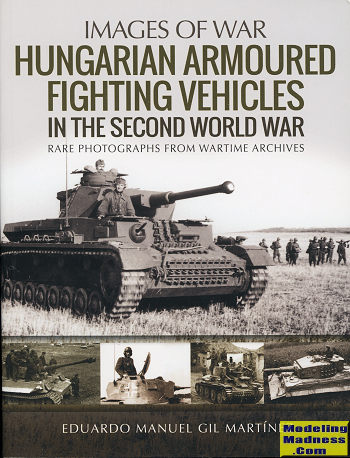 World
War 2 put Hungary in a rather precarious position. A late refuter of the
Versailles treaty, and not exactly the wealthiest nation around, it was fairly
late in developing a decent armored force. Hugary was not without talent in this
regard and was able to produce a fair number of tanks and armored cars locally,
including some license built. They were also well built, but it seems like most
of what was produced was a generation behind those of the warring powers.
Indeed, prior to getting involved, Hungary was more interested in taking back
territory lost as a result of being on the losing side of WWI.
World
War 2 put Hungary in a rather precarious position. A late refuter of the
Versailles treaty, and not exactly the wealthiest nation around, it was fairly
late in developing a decent armored force. Hugary was not without talent in this
regard and was able to produce a fair number of tanks and armored cars locally,
including some license built. They were also well built, but it seems like most
of what was produced was a generation behind those of the warring powers.
Indeed, prior to getting involved, Hungary was more interested in taking back
territory lost as a result of being on the losing side of WWI.
This meant aggression was against its neighbors in
Czechoslovakia, Poland, and Romania, nations that were not much better off and
with military forces that were on a par with those of Hungary. It was able to
get territory from Czechoslovakia as a result of German aggression in 1938/39,
but it required aligning itself with that nation. Joining the Axis meant it was
on the same side as its major rival Romania and that it had to be involved with
the war against the Soviet Union.
War with the Soviets showed that while the Hungarian
armored forces were fairly large, most of their equipment was obsolete. Their
tanks could survive small arms fire, but not anything that the Soviets put up
against them. Hungarian tanks had to get VERY close for their guns to prove
effective, something that rarely happened. Most Hungarian equipment was
basically wiped out in a fairly short period of time and by 1943, they had to
rely almost entirely on German-supplied equipment.
The down side of this is that the Germans rarely
provided up to date armor. Mostly captured stuff from the French or the
Czech-built Panzer 38(t). What few Panzer III/IV were supplied proved effective,
but they were simply a handful or two when hundreds were needed.
This book covers the history of the Hungarian armored
units from before WWII through the period of expansion and into their use both
just before and after Hungary entered WWII. Each of the various chapters
includes a historical section as well as the real draw of this series, a lot of
superb period photos of the men and equipment of the Hungarian armored units.
This includes various prototypes that never made it into production as well as
those German supplied vehicles. However, most of it concentrates on what was
produced in country and that is the main draw of this volume. It is one that I
thoroughly enjoyed reading and it is a book that I can easily recommend to you.
February 2020
Copyright ModelingMadness.com. All rights reserved.
Review book courtesy of
Casemate Publishing, where you can order your copy
at this link.
If you would like your product reviewed fairly and
fairly quickly, please
contact
me or see other details in the
Note to
Contributors.
 World
War 2 put Hungary in a rather precarious position. A late refuter of the
Versailles treaty, and not exactly the wealthiest nation around, it was fairly
late in developing a decent armored force. Hugary was not without talent in this
regard and was able to produce a fair number of tanks and armored cars locally,
including some license built. They were also well built, but it seems like most
of what was produced was a generation behind those of the warring powers.
Indeed, prior to getting involved, Hungary was more interested in taking back
territory lost as a result of being on the losing side of WWI.
World
War 2 put Hungary in a rather precarious position. A late refuter of the
Versailles treaty, and not exactly the wealthiest nation around, it was fairly
late in developing a decent armored force. Hugary was not without talent in this
regard and was able to produce a fair number of tanks and armored cars locally,
including some license built. They were also well built, but it seems like most
of what was produced was a generation behind those of the warring powers.
Indeed, prior to getting involved, Hungary was more interested in taking back
territory lost as a result of being on the losing side of WWI.